| |
Changing Hepatocellular Carcinoma Incidence and Liver Cancer Mortality Rates in the United States..... "US liver cancer mortality rates increased with age in all racial/ethnic groups..... Among individuals aged 50-64 years, blacks had the highest mortality rate (18.6), followed by Hispanics (13.5), Asians/Pacific Islanders (13.0), and whites (7.7)."
|
| |
| |
Download the PDF here
Download the PDF here
Am J Gastroenterol 2014
Sean F Altekruse DVM, PhD1, S Jane Henley MSPH2, James E Cucinelli BA3 and Katherine A McGlynn PhD, MPH4
1. 1Division of Cancer Control and Population Sciences, National Cancer Institute, Rockville, Maryland, USA
2. 2Division of Cancer Prevention and Control, Centers for Disease Control and Prevention, Atlanta, Georgia, USA
3. 3Information Management Services, Silver Spring, Maryland, USA
4. 4Division of Cancer Epidemiology and Genetics, National Cancer Institute, Rockville, Maryland, USA
"After decades of statistically significant increasing HCC incidence rates, during 2007-2010 the trend was no longer statistically significant. The change was partly explained by decreasing incidence rates among Asians/Pacific Islanders, the racial group most affected by HCC, and among men aged 35-49 years. Incidence rates only increased among blacks, Hispanics, and white men and women aged 50+ years. Geographic variation in liver cancer mortality suggests a need for focused liver cancer control efforts in southern and coastal states. Across states, increases in liver cancer mortality rates were most often seen among individuals aged 50-64 years (baby-boomers) and decreasing rates occurred primarily among individuals in the next generation, aged 35-49 years. These findings support the hypothesis that HCC incidence and liver cancer mortality trends vary across race, ethnicity, age, gender, and geographic groups."
"HCC incidence (new cases): Among individuals aged 50-64 years, rates significantly increased by 9.6% per year from 2000 to 2006, then by 5.2% per year from 2006 to 2010. Among individuals aged 65+ years, rates increased 3.6% per year during 2000-2010."
"......Between 2006 and 2010, the US liver cancer mortality rates increased with age in all racial/ethnic groups ( Table 1). All reported mortality rates are per 100,000 people. Among individuals aged 35-49 years, Asians/Pacific Islanders had the highest mortality rates (2.8), followed by blacks (2.0), Hispanics (1.4), and whites (0.9). Among individuals aged 50-64 years, blacks had the highest mortality rate (18.6), followed by Hispanics (13.5), Asians/Pacific Islanders (13.0), and whites (7.7). Mortality rates were highest among Asians/Pacific Islanders aged 65+ years (43.2 per 100,000).......Compared with other racial groups, liver cancer incidence historically has been elevated among Asians/Pacific Islanders. This is attributed to the high rate of chronic hepatitis B virus infection among older adults who were born outside the United States"
As shown in Figure 1b, overall liver cancer mortality rates significantly increased during 2000-2010 (APC=2.1%), with a less rapid increase among individuals aged 65+ years (APC=1.1%) than among individualss aged 50-64 years (APC=5.6%).
"State-specific liver cancer mortality rates.....
Figure 4 presents state-specific liver cancer mortality rates that ranged from 2.3 to 6.8. The highest rates (5.5-6.8) were experienced by the populations of Washington, DC, and three Gulf Coast states (Louisiana, Mississippi, and Texas). The second highest rates were reported in Alabama, Arkansas, California, Hawaii, Nevada, and New Mexico. Coastal, Appalachian, and Midwestern states generally reported higher rates than states in the Northern Plains and Northern Rocky Mountains. Confidence intervals for these rates are presented in Table 4.
State-specific liver cancer mortality trends
When state-specific liver cancer mortality trends during 2000-2010 were examined by age group, striking age-specific patterns were seen (Figure 5). Among individuals aged 35-49 years, rates significantly decreased in 12 states and nonsignificantly decreased in 23 states and Washington, DC, with no state experiencing a significant increase (Figure 5a). In contrast, among individuals aged 50-64 years, rates significantly increased in 41 states and Washington, DC, with no state experiencing a significant decrease (Figure 5b). Rates among individuals aged 65+ years significantly increased in California, Arizona, Oklahoma, Florida, Georgia, Virginia, the District of Columbia, Delaware, New York, Vermont, and Massachusetts, and significantly decreased in Alaska (Figure 5c)."

Figure 1. Age-adjusted SEER 18 HCC incidence and US liver cancer mortality rates by age group and year; 2000-2010. APC, annual percent change; CI, confidence interval; HCC, hepatocellular carcinoma; SEER, Surveillance, Epidemiology and End Results. Trend indicates annual percent change. Joinpoint regression defines when a trend changes. Up to one joinpoint allowed in the 11-year period. *Asterisk indicates slope of trend differs from 0 (P<0.05).

Figure 2. Age-adjusted HCC incidence rates per 100,000 by age group, gender, non-Hispanic race, and Hispanic ethnicity, SEER 18 registries, 2000-2010. HCC, hepatocellular carcinoma; SEER, Surveillance, Epidemiology and End Results.
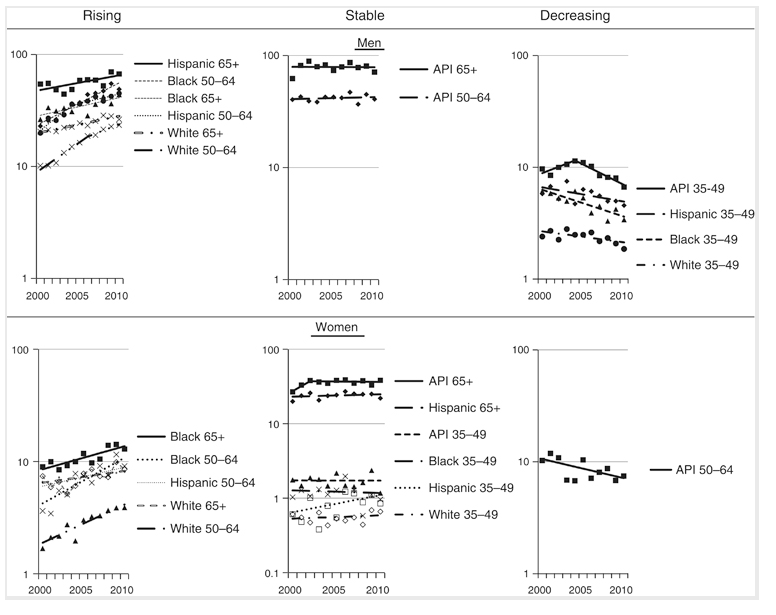
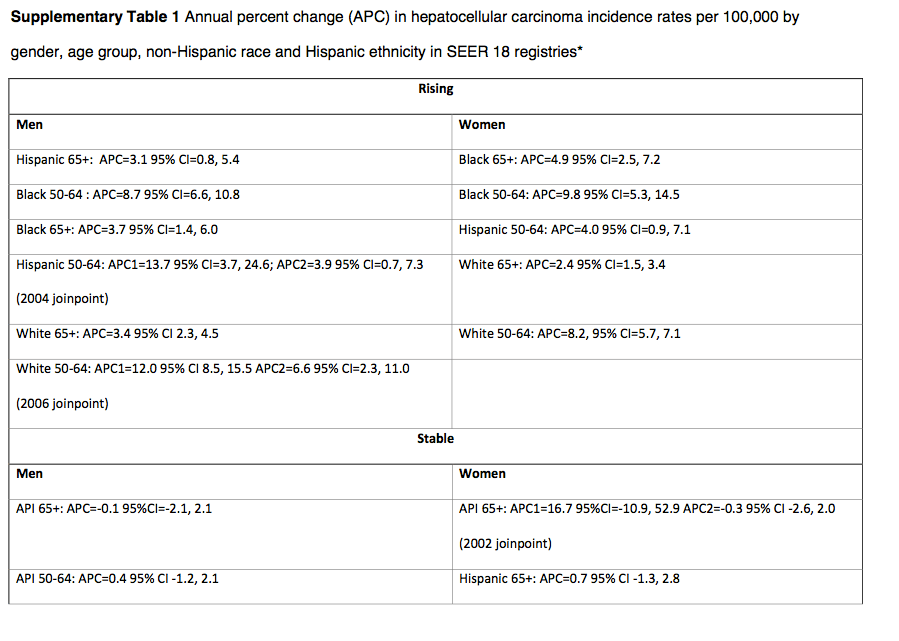
---------------------------------
Changing Hepatocellular Carcinoma Incidence and Liver Cancer Mortality Rates in the United States
Am J Gastroenterol 2014
Sean F Altekruse DVM, PhD1, S Jane Henley MSPH2, James E Cucinelli BA3 and Katherine A McGlynn PhD, MPH4
1. 1Division of Cancer Control and Population Sciences, National Cancer Institute, Rockville, Maryland, USA
2. 2Division of Cancer Prevention and Control, Centers for Disease Control and Prevention, Atlanta, Georgia, USA
3. 3Information Management Services, Silver Spring, Maryland, USA
4. 4Division of Cancer Epidemiology and Genetics, National Cancer Institute, Rockville, Maryland, USA
OBJECTIVES:
The objectives were to describe Surveillance, Epidemiology and End Results (SEER) hepatocellular carcinoma (HCC) incidence trends and the US liver cancer mortality trends by geography, age, race/ethnicity, and gender.
METHODS:
HCC incidence data from SEER 18 registries and liver cancer mortality data from the National Center for Health Statistics were analyzed. Rates and joinpoint trends were calculated by demographic subgroup. State-level liver cancer mortality rates and trends were mapped.
RESULTS:
HCC incidence rates in SEER registries did not significantly increase during 2007-2010; however, the US liver cancer mortality rates did increase. HCC incidence and liver cancer mortality rates increased among black, Hispanic, and white men aged 50+ years and decreased among 35-49-year-old men in all racial/ethnic groups including Asians/Pacific Islanders. Significantly increasing incidence and mortality rates among women were restricted to blacks, Hispanics, and whites aged 50+ years. Asian/Pacific Islander liver cancer mortality rates decreased during 2000-2010 with decreasing rates among women aged 50-64 years and men aged 35-49 years and stable rates in other groups. During 2006-2010, among individuals 50-64 years of age, blacks and Hispanics had higher incidence and mortality rates than Asians/Pacific Islanders. Liver cancer mortality rates were highest in Louisiana, Mississippi, Texas, and Washington, DC.
CONCLUSIONS:
Decreasing HCC incidence and liver cancer mortality rates among Asians/Pacific Islanders, men aged 35-49 years, and the nonsignificant increase in overall HCC incidence rates suggest that the peak of the epidemic may be near or have passed. Findings of geographic variation in mortality rates can inform control efforts.
Introduction
Primary liver cancer is the third largest contributor to cancer mortality in the world (1) and the seventh largest contributor in the United States (2). The burden of liver cancer in the United States is inequitably distributed by gender, age, and race/ethnicity. Incidence rates of hepatocellular carcinoma (HCC), the predominant form of liver cancer, and mortality rates of liver cancer, rise with age and are roughly three times higher among men than women (3). During 2003-2005, in the National Cancer Institute's Surveillance, Epidemiology and End Results (SEER) cancer registries, incidence rates of HCC were more than three times higher among Asians/Pacific Islanders than whites, with intermediate rates among Hispanics, blacks, and American Indians/Alaska Natives (4). US liver cancer mortality rates mirror HCC incidence rates, reflecting the poor survival of this cancer. In many countries, including the United States, HCC incidence rates and liver cancer mortality rates have been increasing for decades. Between 1992 and 2005, the HCC incidence rates in SEER registries increased from 3.1 to 5.1 per 100,000 persons, and US liver cancer mortality rates rose from 3.3 to 4.0 per 100,000 persons (4).
Models based on the prevalence of an important cause of liver cancer in the United States, chronic infection with hepatitis C virus (HCV), have predicted that HCC incidence will continue to climb for the next several decades (5). However, these models have not considered the changing prevalence of HCV and other risk factors (3). Whether predicted models of HCC trends are accurate remains uncertain. To characterize trends in the United States in the early twenty-first century, HCC incidence and liver cancer mortality rates were examined by demographic characteristics.
Methods
Incidence
Cancer incidence data during 2000-2010 were obtained from all 18 SEER registries, which cover 28% of the US population (6). Liver cancer incidence was defined by International Classification of Diseases for Oncology, Third Edition (7) using topography codes C22.0 and C22.1. HCC cases were restricted to morphology codes 8170-8175. Of the 87,988 malignant liver and intrahepatic cancer diagnoses reported during 2000-2010 in SEER 18 registries, 63,735 (72%) were classified as HCCs.
Mortality
The US data on cause of mortality during the years 2000-2010 were reported by the Centers for Disease Control and Prevention, National Center for Health Statistics (8). Deaths because of liver cancer were identified by International Classification for Diseases version 10 codes for the underlying cause of death (9), using codes C22.0-C22.9 (malignant neoplasm of liver and intrahepatic bile ducts), excluding C22.1 (intrahepatic bile duct cancer). To improve completeness of classification, mortality rates among Hispanics and non-Hispanics were restricted to areas that met data quality measures for reporting of Hispanic ethnicity, thereby excluding the populations of New Hampshire, North Dakota, South Carolina, and Washington, DC, that account for ~2% of the US population (10). The current analysis was based on 138,326 reported liver cancer deaths, after excluding 27,203 intrahepatic bile duct cancer deaths. Sensitivity analyses of mortality trends that restricted cases and populations to SEER registry areas were performed.
Populations
Data on HCC incidence and liver cancer mortality were linked to Census Bureau population denominator data for 2000 through 2010, with data by geographic location, gender, age, and race/ethnicity (non-Hispanic white, black, Asian/Pacific Islander, and Hispanic) (11). American Indians/Alaska Natives were not included in the current study as small counts yielded unstable rate estimates.
Statistical analysis
Average annual HCC incidence and liver cancer mortality rates per 100,000 persons were estimated for the most recent 5-year period of diagnoses, 2006-2010 (SEER*Stat v 7.0. 9, Information Management Services, Silver Spring, MD). Rates were age adjusted by the direct method to the 2000 US standard population (19 age groups) (12). Rates and trends were examined by age group (overall, 35-49, 50-64, and 65+ years of age), gender, non-Hispanic race, and Hispanic ethnicity. Joinpoint regression (13) allowing two segments was used to fit age-adjusted trends for 2000-2010 (Joinpoint v 3.5, Information Management Services). Annual percent change (APC) was considered statistically significant when the regression line slope differed from zero (P<0.05).
State-specific liver cancer mortality rates per 100,000 persons during 2006-2010 were age adjusted by the direct method to the 2000 US standard population (19 age groups) (12). We used the Jenks natural break classification method (14) to map six categories: states with 2.3-2.9 deaths per 100,000 (5 states), 3.0-3.5 deaths per 100,000 (11 states), 3.6-4.0 deaths per 100,000 (13 states), 4.1 to 4.5 deaths per 100,000 (12 states), 4.6 to 5.5 deaths per 100,000 (6 states), and 5.6 to 6.8 deaths per 100,000 (3 states and Washington, DC). State rates were compared with those for two underlying causes: diabetes mellitus and chronic liver diseases including cirrhosis.
Maps of liver cancer mortality rate trends for age groups 35-49, 50-64, and 65+ years, based on a single joinpoint segment model for the period 2000-2010 categorized states into five groups, based on criteria used in the National Cancer Institute's Cancer Trends Progress Report (15). Group 1: significant decrease (rate decreasing, statistically significant APC); group 2: nonsignificant decrease (rate decrease more than 0.5% per year, APC not statistically significant); group 3: stable (absolute value of rate change 0.5% per year, APC not statistically significant); group 4: nonsignificant increase (rate increase >0.5% per year, APC not statistically significant); and group 5: significant increase (Rate increasing with a statistically significant APC). National mortality trends for two underlying causes of liver cancer (i) liver disease and cirrhosis and (ii) diabetes mellitus were compared with those for liver cancer. Using the five-category trend variable, correlations with state-level mortality trends were examined with the CORR procedure (SAS v 9.3, Cary, NC). State-level maps of liver cancer mortality rates and trends were drawn using ArcMap 10.0 (ESRI, Redlands, CA).
RESULTS
HCC incidence
As shown in Table 1, HCC incidence increased with age in all racial/ethnic groups in the interval 2006-2010, with the exception of blacks, for whom rates were higher among individuals 50-64 than 65+ years of age. All reported incidence rates are per 100,000 people. Overall, Asians and Pacific Islanders had the highest incidence rates, followed by Hispanics, blacks, and, last, whites. Among individuals aged 35-49 years, Asians and Pacific Islanders had the highest HCC incidence rate (4.7), followed by Hispanics (3.2), blacks (2.5), and whites (1.4). Among individuals aged 50-64 years, blacks had the highest incidence rate (26.9), followed by Hispanics (24.3), Asians and Pacific Islanders (23.5), and whites (12.2). The very highest age-specific rates were experienced by Asians and Pacific Islanders aged 65+ years (54.7 per 100,000).

Between 2000 and 2010, incidence significantly increased by 5.4% per year during 2000-2007, then nonsignificantly by 2.3% per year during 2007-2010 (Figure 1a). Among individuals aged 35-49 years, incidence rates nonsignificantly decreased by 1.4% per year during 2000-2010. Among individuals aged 50-64 years, rates significantly increased by 9.6% per year from 2000 to 2006, then by 5.2% per year from 2006 to 2010. Among individuals aged 65+ years, rates increased 3.6% per year during 2000-2010.
Overall rates significantly increased among whites during 2000-2008 (5.9% per year), and then nonsignificantly increased by 1.3% per year during 2008-2010 ( Table 2). Overall rates increased during 2000-2010 among blacks and Hispanics (5.6 and 3.3% per year respectively). Among Asians/Pacific Islanders, overall rates nonsignificantly increased during 2000-2002 (8.2% per year) followed by a period of borderline statistically significant decrease during 2002-2010 (-1.2% per year).
HCC incidence trends by race, age, and gender are shown in Figure 2 with APCs presented in Supplementary Table 1 online. Age- and race-specific rates were higher among men than women. Significantly increasing trends occurred only among Hispanics, whites, and black men and women aged 50-64 and 65+ years, with the exception of a stable trend among Hispanic women aged 65+ years. Rates were also stable among Asian/Pacific Islander women aged 65+ years and women aged 35-49 years in all racial/ethnic groups. Among men, rates were stable for Asians/Pacific Islanders aged 50-64 and 65+ years. Significantly decreasing HCC incidence rates were experienced among Asians/Pacific Islanders and white and black men aged 35-49 years, with a borderline statistically significant decrease among Hispanic men in this age group. Among women, rates significantly declined only for Asian/Pacific Islanders aged 50-64 years. APCs and confidence intervals for HCC incidence trends are presented in Table 3a.
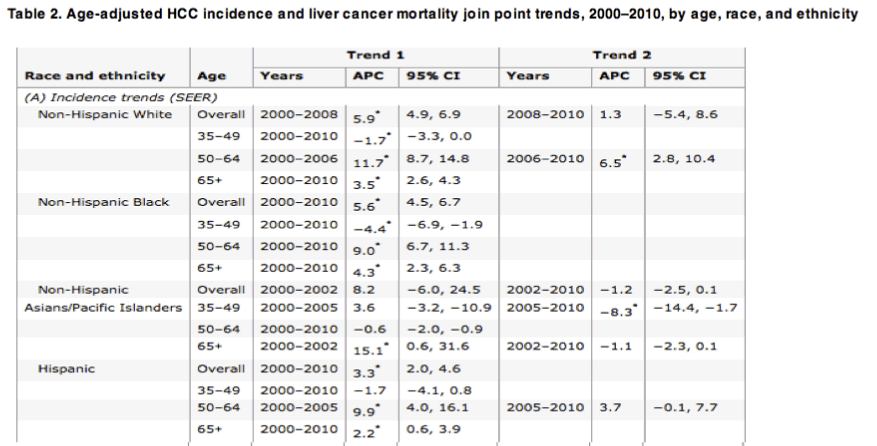
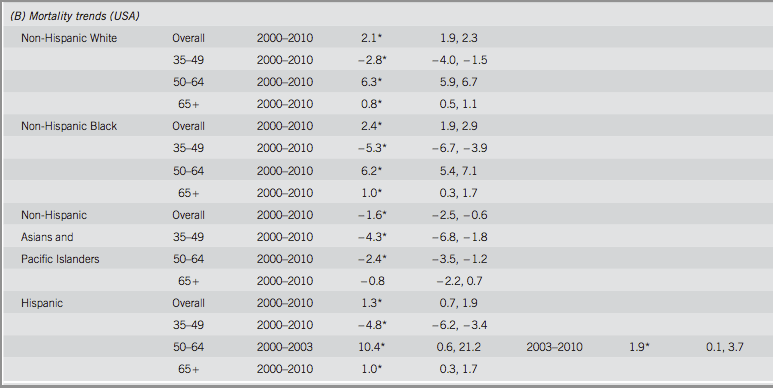

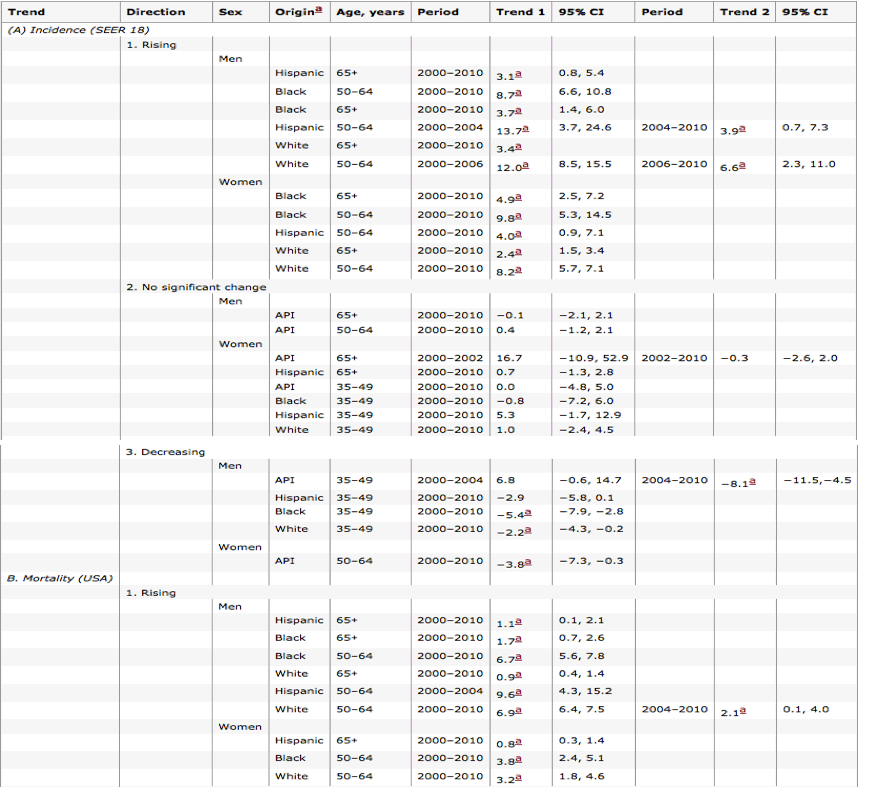
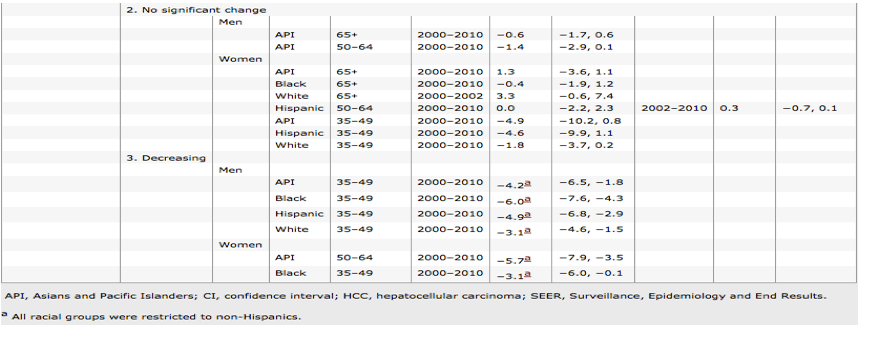
Liver cancer mortality
Between 2006 and 2010, the US liver cancer mortality rates increased with age in all racial/ethnic groups ( Table 1). All reported mortality rates are per 100,000 people. Among individuals aged 35-49 years, Asians/Pacific Islanders had the highest mortality rates (2.8), followed by blacks (2.0), Hispanics (1.4), and whites (0.9). Among individuals aged 50-64 years, blacks had the highest mortality rate (18.6), followed by Hispanics (13.5), Asians/Pacific Islanders (13.0), and whites (7.7). Mortality rates were highest among Asians/Pacific Islanders aged 65+ years (43.2 per 100,000).
As shown in Figure 1b, overall liver cancer mortality rates significantly increased during 2000-2010 (APC=2.1%), with a less rapid increase among individuals aged 65+ years (APC=1.1%) than among individualss aged 50-64 years (APC=5.6%). There was a significant decrease, however, among individuals aged 35-49 years (APC=-3.2%).
The US liver cancer mortality trends by race/ethnic group during 2000-2010 are shown in Table 2b. Overall, rates significantly increased during 2000-2010 among whites, blacks, and Hispanics (2.1%, 2.4%, and 1.3% per year, respectively); however, rates among Asians/Pacific Islanders significantly decreased (-1.6% per year). Sensitivity analyses restricted to SEER areas revealed mortality trends comparable to US patterns in both magnitude and statistical significance (data not shown).
The US liver cancer mortality trends by race, age, and gender are shown in Figure 3 with APCs presented in Supplementary Table 2. Age- and race-specific rates were higher among men than women. Significantly increasing trends occurred only among Hispanics and white and black men aged 50-64 and 65+ years, Hispanic women aged 65+ years, and black and white women aged 50-64 years. Mortality rates did not significantly change for women in other population subgroups except for decreasing trends among black women aged 35-49 years and Asian/Pacific Islander women aged 50-64 years. Among men, mortality rates were stable for Asian/Pacific Islanders aged 50-64 and 65+ years and significantly decreased among Asians/Pacific Islanders, blacks, Hispanics, and white men aged 35-49 years. APCs and confidence intervals for these trends are presented in Table 3b.
State-specific liver cancer mortality rates
Figure 4 presents state-specific liver cancer mortality rates that ranged from 2.3 to 6.8. The highest rates (5.5-6.8) were experienced by the populations of Washington, DC, and three Gulf Coast states (Louisiana, Mississippi, and Texas). The second highest rates were reported in Alabama, Arkansas, California, Hawaii, Nevada, and New Mexico. Coastal, Appalachian, and Midwestern states generally reported higher rates than states in the Northern Plains and Northern Rocky Mountains. Confidence intervals for these rates are presented in Table 4.
Figure 4. Age-adjusted liver cancer mortality rates per 100,000 by state, 2006-2010.
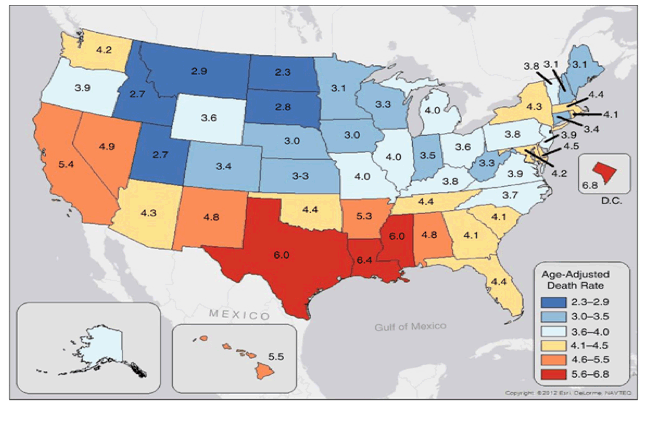
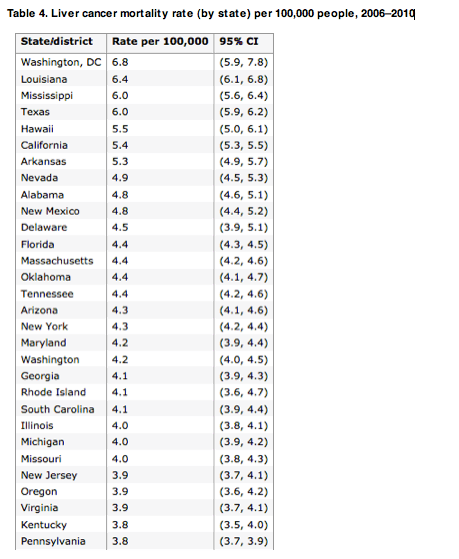
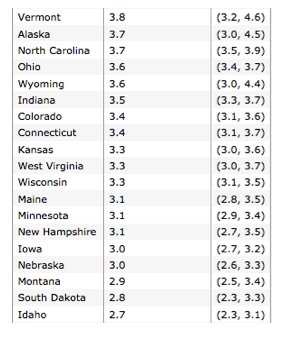
Among the top 10 liver cancer death rate areas, only New Mexico was a top 10 state for mortality from both diabetes mellitus and chronic liver diseases. Five other states ranked in the top 10 for diabetes mellitus mortality (Louisiana, Arkansas, Mississippi, Alabama, and Washington, DC). Three more states were top 10 states for chronic liver disease mortality (California, Nevada, and Texas). Only Hawaii was in the bottom 10 for both underlying causes of mortality (data not shown).
State-specific liver cancer mortality trends
When state-specific liver cancer mortality trends during 2000-2010 were examined by age group, striking age-specific patterns were seen (Figure 5). Among individuals aged 35-49 years, rates significantly decreased in 12 states and nonsignificantly decreased in 23 states and Washington, DC, with no state experiencing a significant increase (Figure 5a). In contrast, among individuals aged 50-64 years, rates significantly increased in 41 states and Washington, DC, with no state experiencing a significant decrease (Figure 5b). Rates among individuals aged 65+ years significantly increased in California, Arizona, Oklahoma, Florida, Georgia, Virginia, the District of Columbia, Delaware, New York, Vermont, and Massachusetts, and significantly decreased in Alaska (Figure 5c).
Figure 5. Annual percent change (APC) in liver cancer mortality rates by state during 2000-2010 by age group. (a) 35-49, (b) 50-64 and (c) 65+ years of age.
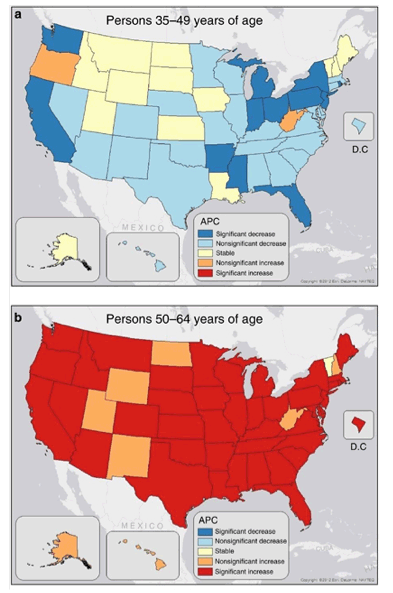
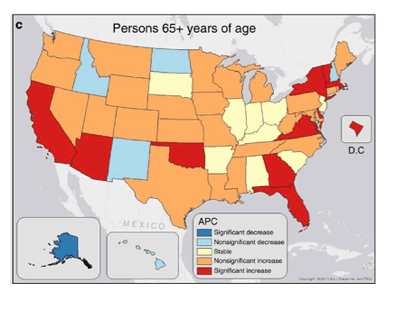
Table 5 presents national mortality trends for liver cancer and two underlying causes of liver cancer: (i) chronic liver disease and cirrhosis and (ii) diabetes mellitus. The direction of liver cancer mortality trends were consistent with those for chronic liver disease and cirrhosis in 35-49-year-old individuals, for whom both causes of death significantly decreased, and 50-64-year-old individuals, for whom both causes of death significantly increased. There was also a statistically significant correlation between the liver cancer and chronic liver disease and cirrhosis trends among individuals 50-64 year of age (P=0.03).
DISCUSSION
After decades of statistically significant increasing HCC incidence rates, during 2007-2010 the trend was no longer statistically significant. The change was partly explained by decreasing incidence rates among Asians/Pacific Islanders, the racial group most affected by HCC, and among men aged 35-49 years. Incidence rates only increased among blacks, Hispanics, and white men and women aged 50+ years. Geographic variation in liver cancer mortality suggests a need for focused liver cancer control efforts in southern and coastal states.
Across states, increases in liver cancer mortality rates were most often seen among individuals aged 50-64 years (baby-boomers) and decreasing rates occurred primarily among individuals in the next generation, aged 35-49 years. These findings support the hypothesis that HCC incidence and liver cancer mortality trends vary across race, ethnicity, age, gender, and geographic groups.
HCC incidence trends are affected by the changing prevalence of risk factors. In the United States, an important risk factor is HCV infection (16), particularly among individuals born between 1945 and 1965, commonly referred to as "baby-boomers" (17). Other HCC risk factors include chronic hepatitis B virus infection (18), obesity (19), diabetes (20), nonalcoholic fatty liver disease (21), and excessive alcohol use (22), all of which occur at variable frequencies across sociodemographic sectors of the population (23,24,25,26,27). Each of these factors predisposes to cirrhosis, the precursor of most HCC. This report found parallel age-specific mortality trends for liver cancer and chronic liver disease including cirrhosis and elevated mortality rates for diabetes mellitus or chronic liver disease in states with high liver cancer death rates. These findings should however be interpreted cautiously because in the past, individuals with cirrhosis tended to die from the disease. However, as treatment has improved, the risk of death from cirrhosis has declined and, as a consequence, the risk of HCC developing among individuals with cirrhosis may be increasing (28). It is plausible that a similar dynamic could also exist with respect to diabetes mellitus mortality.
Consistent with prior studies of HCC incidence in the United States, the continuing increase in the US liver cancer mortality rates was driven by increasing trends among blacks, whites, and Hispanics (4,29,30). In this report, liver cancer mortality rates among adults aged 50-64 years were significantly higher for blacks than other racial/ethnic groups. Although not statistically significant, for the first time, Hispanics aged 50-64 years had higher HCC incidence and liver cancer mortality rates than Asians/Pacific Islanders. Better estimates of the fraction of HCC cases in affected subgroups attributable to specific etiologies would facilitate screening of at-risk people.
Compared with other racial groups, liver cancer incidence historically has been elevated among Asians/Pacific Islanders. This is attributed to the high rate of chronic hepatitis B virus infection among older adults who were born outside the United States (16). A previous report observed that liver cancer mortality rates among Asians/Pacific Islanders declined 0.9% per year from 1992 to 2005 (4). The present report found a more rapid rate of decline (-1.6%) during 2000-2010. Cultural awareness of liver cancer risk may incentivize hepatitis B virus and liver cancer screening and related therapies in this racial group that will further decrease liver cancer mortality rates.
Declining liver cancer mortality rates among young adults aged 35-49 years may signal a future decline in overall US liver cancer mortality rates. This was the case in Japan, where liver cancer mortality peaked a generation earlier than in the United States among the Japanese birth cohort born during 1925-1939 (35,36).
A decrease in Japanese liver cancer mortality began around 1985, and was first evident in the sentinel group of young adults ~40 years of age (36). The reversal of liver cancer mortality trends in Japan has been attributed to declining exposure to HCV-related risk factors that included injected drug use and contaminated blood product transfusion in the post-World War II era (36).
Recent HCV screening guidelines for individuals born during 1945-1965 (17) combined with advances in treatment of HCV infection (31,32) and guidelines for HCC screening and therapy (33) may accelerate progress in reducing US liver cancer mortality rates. Although 3.2 million people in the United States currently have chronic HCV infection, the rate of new infection has greatly decreased (17,34). Until recently, the standard of care for HCV-infected individuals consisted of lengthy treatment with interferon and ribavirin. Historically, treatment has been a challenge because of limited treatment success and discontinuation due to adverse effects. Progress has been made, however, and future regimens are likely to incorporate multiple direct-acting antiviral drugs. In 2011, the Food and Drug Administration (FDA) approved two direct-acting antiviral agents for individuals infected with HCV genotype 1: telaprevir and boceprevir (31). In addition, there are other promising drugs in development that target HCV-encoded proteins. At present, prescribed drug regimens cure ~80% of HCV patients. Although cost of treatment remains an impediment, improving treatments could have a considerable downward effect on future HCC incidence rates, particularly among the baby-boomer cohort.
In this study, the US liver cancer mortality rates continued a statistically significant rise, whereas the increase in HCC incidence rates in SEER registries was no longer statistically significant. Several factors could explain the discrepancy. Mortality statistics cover 98% of the United States, whereas SEER registries cover 28%, and areas with the highest mortality rates including Texas, Mississippi, and the District of Columbia are not in the SEER catchment. Underlying trends may differ between the US and SEER areas. Second, liver cancer mortality data are based on the underlying causes of death on death certificates. When the cause of death is not fully documented, it can result in an undercount. Such errors are less likely with cancer incidence data that are based on detailed abstractions of medical records. Third, although HCC is the dominant histologic type of liver cancer, it is not the sole type, and rarer types do contribute to mortality rates. In addition, the liver is a common site of metastasis, and thus some secondary liver cancers could be mistakenly over counted as primary liver cancer. Despite these potential sources of misclassification, incidence and mortality trends in SEER areas generally mirrored the US mortality trends.
As this is the first year in decades during which recent HCC incidence rates did not significantly increase, caution is warranted against overinterpretation. HCC incidence rates should be monitored over time to assess whether the direction of the trend turns downward, remains constant, or increases. The strengths of this study include the ability to examine HCC incidence in 28% and liver cancer mortality in 98% of the US population by age, sex, and race/ethnicity. Limitations include the absence of data on etiological risk factors. Despite limitations, the data provide insight into changes in HCC incidence and liver cancer mortality rates across demographic strata of the US population.
In summary, although overall liver cancer mortality rates increased during 2000-2010, recent HCC incidence rates did not significantly increase. Decreasing mortality rates among adult men aged 35-49 years and Asians/Pacific Islanders suggest that the peak of the epidemic may be near or have passed. Findings of geographically variable liver cancer mortality rates may help target affected areas.
|
|
| |
| |
|
|
|